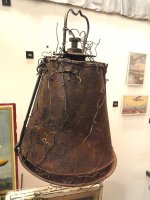I have been listening to one of Martin Liedtke's videos today, and he showed one of the most famous post-calamity photographs of San Francisco. His image had the below airship depicted on it.

Here is a screenshot of the photograph.

As far as I understand, these here are the alleged original scans of this photograph. Needless to say, there is no airship on these.
I did some searching around, and found this page, but the image cannot be enlarged. I also found this photograph. Right next to the airship we have "Think Atheist". Additionally, we have the airship "equipped" photograph here (7000px by 2748px), but there is no "Think Atheist" next to the aircraft.
KD: Considering that most of the sources of this particular photograph are various desktop wallpaper websites, I doubt that the "airshipped" photograph is legit. At the same time... stranger things happen.
- The Video - listen for Martin's picture related opinion.
As far as I understand, these here are the alleged original scans of this photograph. Needless to say, there is no airship on these.
I did some searching around, and found this page, but the image cannot be enlarged. I also found this photograph. Right next to the airship we have "Think Atheist". Additionally, we have the airship "equipped" photograph here (7000px by 2748px), but there is no "Think Atheist" next to the aircraft.
KD: Considering that most of the sources of this particular photograph are various desktop wallpaper websites, I doubt that the "airshipped" photograph is legit. At the same time... stranger things happen.
- What do you think we are looking at here? Steampunk photoshop or not?





